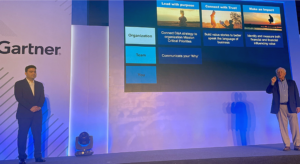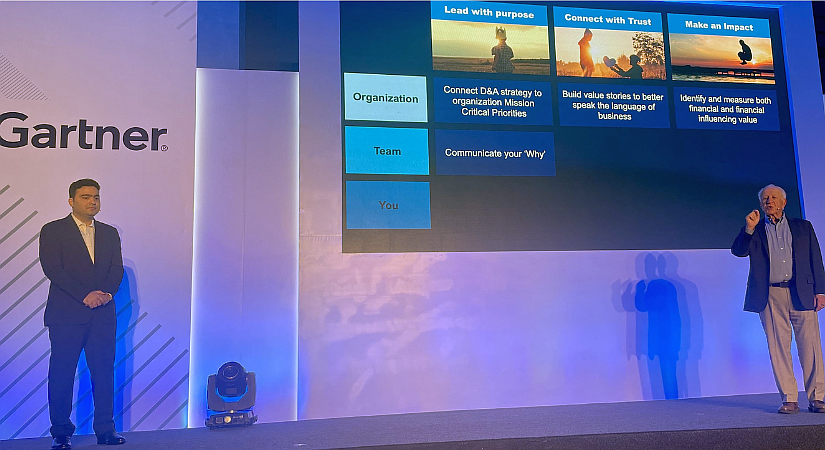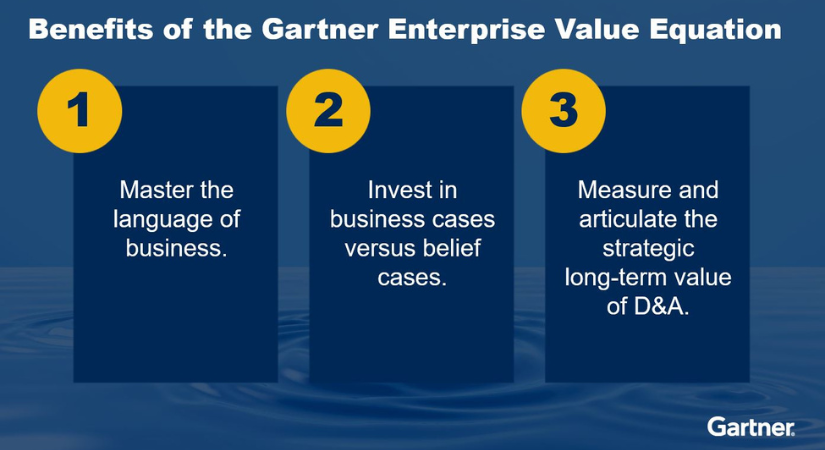I attended the first day of the Gartner Data & Analytics Summit 2023 in Mumbai, on 8 May. And I’d like to share some highlights from the keynote and other sessions. Since there were breakouts after the morning keynote, I had to select my sessions carefully. The highly versatile Conference Navigator app helped me plan in advance – I could even download the speaker presentations! Keynote: The perfectly scripted and flawless keynote by Donald Feinberg, Distinguished VP Analyst and Ehtisham Zaidi, VP Analyst, showed how (D&A) leaders can deliver increasing value to their organizations. The keynote highlighted new ways for D&A leaders to connect with stakeholders, address skills shortages and lead with purpose to ensure the data-driven transformation required for success. Listen to the keynote

Ehtisham Zaidi, VP Analyst at Gartner,and Donald Feinberg, Distinguished VP Analyst at Gartner deliver the opening keynote. Image: Gartner
Audio credit: Gartner Key takeaways from the keynote (and the video testimonials played during the keynote):
- 5 of the top 6 challenges are people-related
- Tech is not the solution to our most significant challenges
- Many people are still using spreadsheets to analyze data
- Business leaders don’t understand the potential of D&A
- Lead for purpose and lead from the heart
- Be a people person. Listen to others
- Connect with trust – build positive relations
- Make an impact
- Communicate. Great leaders should communicate why they do it
- Focus on the value story for stakeholders
- Use the Gartner Enterprise Value Equation to deliver value
- Hiring: Hire for curiosity. Consider “quiet hiring”
- Hiring: Redeploy existing resources to fill skill shortages
- Adapt global ways of thinking for a local market
- Open a D&A franchise in each department
- Data-driven culture through a D&A Franchise
- Open a D&A Franchise in each department
Some impactful quotes from the keynote presenters:
- The most common roadblocks to the success of D&A initiatives are all human-related challenges, such as skills shortages, lack of business engagement, difficulty accepting change and poor data literacy throughout the organization.”
- “D&A leaders are still not speaking the language of business, but we’re under intense pressure to demonstrate the value of our initiatives to other business peers and executives.”
- “Much of what we do in D&A is strategy enablement, which by definition plays out over a longer period of time. We need a new way to talk about investments in D&A to show future impact and how they meet the needs of multiple stakeholders.”
- “Think about speaking the language of business. Now more than ever, D&A leaders must have a translation layer between their D&A initiatives and the organization’s mission-critical priorities.”
- “Make business stakeholders the hero in your business value story by meeting their KPIs and enabling their objectives by connecting them with data and analytics insights.”
- “Culture is the reason we say we fail. Even the highest ranking executives in your organization can’t change the whole culture, but you can change the culture around you to a data-driven one.”
Knowledge Sessions
Some highlights from the other sessions:
- By 2027, organizations investing in AI will process 60% of IT and digital initiatives to the approval stage without human intervention.
- By 2025, 55% of IT departments will adopt data ecosystems, which will consolidate the vendor landscape by 40%, reducing cost while reducing choice. “The data ecosystem consists of an end-to-end set of integrated tools that simplify and reduce the time required to develop applications for all data use cases.”
- By 2025, 75% of data will be generated outside of these centralized facilities. “Currently, most enterprise data is generated in centralized data centers or cloud regions, however, this pattern will dramatically change in the future.”
- “Applications, AI training, and inference will need to move closer to edge environments near IoT endpoints as the need for processing data at the point of creation grows.”
- By the end of 2025, there will be 11.7 billion IoT devices and their capabilities will expand as compute, security and bandwidth technology evolves. “This will create a rich foundation for edge analytics capabilities to be widely available.”
- By 2024, 60% of intelligent software-as-a-service (SaaS) will be composed from packaged business capabilities providing data, analytical insight and operational application services. “Generative AI is an emerging technology that has only begun to be exploited commercially.”
- By 2025, the concentration of pretrained AI models among 1% of AI vendors will make responsible AI a societal concern. “Adopt a risk-proportional approach to deliver AI value.”
Reporter’s notes
- Natural language evolution will bridge structured and unstructured data using semantic networks and neural networks.
- Unlock data and blind spots by closing the loop with structured and unstructured data.
- Technical debt in AI is mostly in the data space. It will become a problem in the next few years.
- Models will come and go. Retain your information architecture.
- The biggest challenge with AI today is how we interact with AI systems (the UI).
- Develop a data fabric for information.
- Loosely coupled design and information platforms to tools and AI services.
- 82% of enterprises say data quality is one of the biggest barriers in data integration projects.
- Data governance is not simple in today’s hybrid, multi-cloud environments.
- A data lakehouse is a new approach to combine the advantages of data warehouse and data lake.
- Analytics can drive business value. We need business champions to spread the word.
DIGITAL CREED is an initiative by technology journalist Brian Pereira










